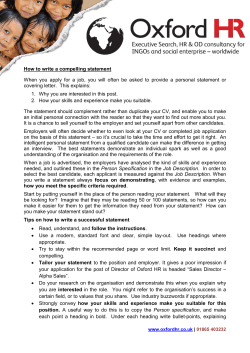
ORGANISATION STRUCTURE
ORGANISATION STRUCTURE AND DESIGN Organisation Structure and Design Organisation Structure - It is the formal arrangement of jobs within an organisation. Organisation Design - The process of creating or changing structure, is called organisational design and involves decisions regarding ◦ ◦ ◦ ◦ ◦ ◦ Work specialisation Departmentalisation Chain of command Span of control Centralisation and decentralisation Formalisation PURPOSE OF ORGANISING Divides work to be done into specific jobs and departments Assigns tasks and responsibilities associated with individual jobs Coordinates diverse organizational tasks Clusters jobs into units Establishes relationships among individuals, groups, and departments Establishes formal lines of authority Allocates and deploys organizational resources WORK SPECIALISATION It is dividing work activities into separate job tasks. Individual employees specialise in doing a part of the activity rather that the entire activity in order to increase work output. (Division of labour concept) Thus work specialisation increases efficiency however, if carried to extremes, it can lead to reduced performance, boredom, fatigue, stress, poor quality, increased absenteeism and turnover. ECONOMIES AND DISECONOMIES OF WORK SPECIALISATION DEPARTMENTALISATION It is the basis on which jobs are grouped together. Functional departmentalisation Geographical departmentalisation Product departmentalisation Process departmentalisation Customer departmentalisation Cross functional teams – recent trends CHAIN OF COMMAND The line of authority extending from upper organisation levels to the lowest levels, which clarifies who reports to whom. Authority – the rights inherent in a managerial position to tell people what to do and expect them to do it. Responsibility – the obligation or expectation to perform any assigned duties Unity of command – the management principle (by Fayol) that each person should report to only one manager. Delegation - The assignment of authority to another person to carry out specific duties CHAIN OF COMMAND The concept of chain of command has less relevance today because of advancements in IT and trend towards empowering employees. New structural designs such as self managed and cross functional teams make the concept of chain of command less relevant SPAN OF CONTROL It is the number of employees a manager can efficiently and effectively manage. Span of control determines the number of levels and managers in an organisation – hence the cost. Generally, the wider of larger the span of an organisation , the more efficient it is. Many factors influence the number of employees that a manager can efficiently and effectively manage including ◦ ◦ ◦ ◦ ◦ ◦ ◦ ◦ skills and abilities of the manager and employees characteristic of the work being done similarity and complexity of employees tasks physical proximity of subordinates degree to which standardised procedures are in place the sophistication of the organisation’s information system strength of organisation culture preferred style of management. SPAN OF CONTROL Narrow span of controls are expensive and add levels of management Vertical communication is made difficult in narrow spans of control They slow decision making process and isolate upper management Narrow spans of control encourage overly tight supervision and discourage employee autonomy. Recent trends have been towards wider spans of control To ensure that performance doesn’t suffer in wider spans, more investment is being made in employee training CENTRALISATION AND DECENTRALISATION Centralisation is the degree to which decision making takes place at the upper levels of the organisation. The degree to which lower-level employees provide input or actually make decisions is decentralisation. Employee empowerment is the trend nowadays. Centralisation-decentralisation is relative not absolute no organisation is completely centralised or decentralised CENTRALISATION - ADVANTAGES Facilitates coordination Helps ensure that decisions are consistent with organisation’s objectives Avoids duplication of activities Useful in times of organisation change DECENTRALISATION - ADVANTAGES Decreases burden on top management Increases motivation of employees More rapid response to environmental change Results in better decisions Increases control FACTORS AFFECTING CHOICE BETWEEN CENTRALISATION AND DECENTRALISATION Nature of decision to be made Economies of scale Local adaptation Uncertain and dynamic environment FORMALISATION How standardised an organisation’s jobs are and the extent to which employee behaviour is guided by rules and procedures. In highly formalised organisations, employees have little discretion over what’s done, and how its done. Functional Structure Multidivisional structure Geographic Structure Hybrid Structure Unilever’s Structure Matrix Structure CONTEMPORARY ORGANISATION DESIGNS Boundaryless structure ◦ Term coined by Jack Welsh, GE’s former chairman ◦ He seeked to eliminate the vertical and horizontal boundaries with GE and the external barriers between the company and it’s suppliers and custmers ◦ These organisations seek to eliminate the chain of command, have limitless spans of control, and replace the departments with emplowered teams ◦ It relies heavily on IT and is sometimes called T-form (technology based) organisation ◦ Flattended hierarchy (status and ranks are minimised) through cross hiearchial teams, participative decision making, use of 360 degree performance appraisals ◦ Horizontal barriers are removed through cross functional teams CONTEMPORARY ORGANISATION DESIGNS Team structure ◦ Breaks down departmental barriers and decentralizes decision making to the level of work teams ◦ In larger organisations team structure (flexibility) complements the bureaucracy structure (standardisation) ◦ Employees are more involved and empowered; reduced barriers among functional areas ◦ no clear chain of command; pressure on teams to perform CONTEMPORARY ORGANISATION DESIGNS The virtual organisation ◦ It is also called network or modular organisation ◦ It is typically a small, core organisation that outsources major business functions ◦ Highly centralised with little or no departmentalisation ◦ Maximum flexibility – allows individuals with innovative ideas and minimum money to successfully compete against giants in the industry CONTEMPORARY ORGANISATION DESIGNS Network Organization - A small core organization that outsources its major business functions (e.g., manufacturing) in order to concentrate on what it does best Modular Organization - A manufacturing organization that uses outside suppliers to provide product components for its final assembly operations Problems in Outsourcing Choosing the wrong activities to outsource Choosing the wrong vendor Writing a poor contract Failing to consider personnel issues Losing control over the activity Ignoring the hidden costs Failing to develop an exit strategy (for either moving to another vendor, or deciding to bring the activity back in-house) LEARNING ORGANISATION An organization that has developed the capacity to continuously learn, adapt, and change through the practice of knowledge management by employees An open team-based organization design that empowers employees Extensive and open information sharing Leadership that provides a shared vision of the organization’s future; support; and encouragement A strong culture of shared values, trust, openness, and a sense of community LEARNING ORGANISATION MECHANISTIC ORGANISATION High specialisation Rigid departmentalisation Clear chain of command Narrow spans of control Centralisation High formalisation These organisations strive for efficiency and rely heavily on rules, regulations, standardised tasks and similar controls. ORGANIC ORGANISATION Cross functional teams Cross hierarchical teams Free flow of information Wide spans of control Decentralisation Low formalisation This structure is highly flexible and adaptive FACTORS INFLUENCING CHOICE OF ORGANISATION STRUCTURE Strategy ◦ Differentiation (Innovation) – Organic structure ◦ Cost minimisation – Mechanistic Size ◦ Larger organisations are more Mechanistic Technology – degree of routiness ◦ Routine technologies – taller and more departmentalised structures, high formalisation, high centralisation (but high formalisation may result in decentralisation) FACTORS INFLUENCING CHOICE OF ORGANISATION STRUCTURE Environment ◦ Assessed through capacity (abundant or scarce), volatility (stable or volatile) and complexity (simple or complex) ◦ Organizations operating in scarce, dynamic and complex environments face the greatest uncertainty because they have little room for error, high unpredictability and diverse set of elements in the environment to monitor and usually have more organic structures TODAY’S ORGANISATION DESIGN CHALLENGES Keeping employees connected Building a learning organisation Managing global structural issues
© Copyright 2025









